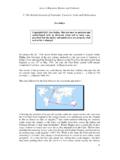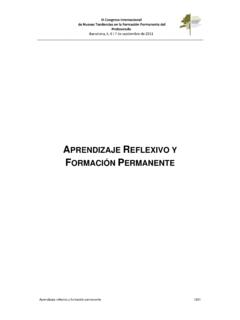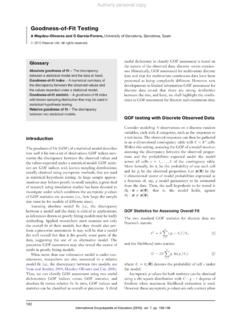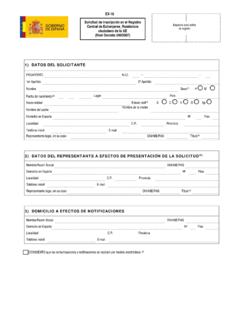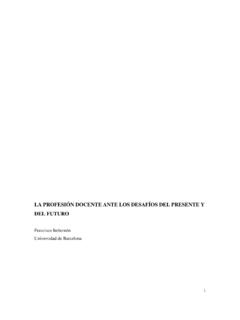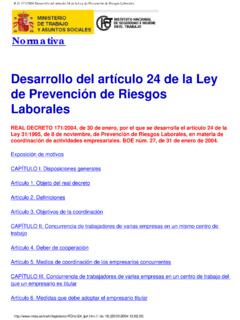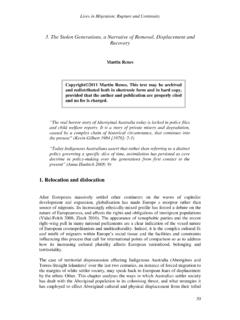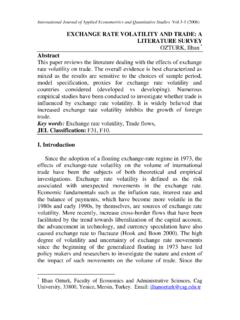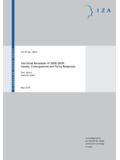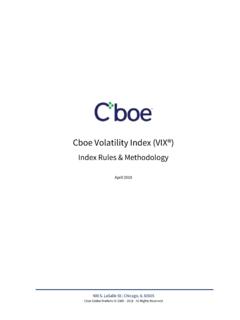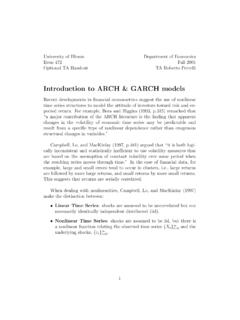Transcription of Introduction to Quantitative Finance
1 Introduction to Quantitative FinanceJos CorcueraContents1 Financial Discrete time models .. Strategies of investment .. Admissible strategies and arbitrage .. Martingales and opportunities of arbitrage .. Complete markets and option pricing .. American options .. The optimal stopping problem .. Application to American options .. Continuous-time models .. Continuous-time Martingales .. Stochastic Integration .. It o s Calculus .. The Girsanov theorem .. The Black-Scholes model .. Multidimensional Black-Scholes model with continuous div-idends .. Currency options .. Stochastic volatility .. Fourier methods for pricing .. 672 Interest rates Basic facts .. The yield curve .. Yield curve for a random future .. Interest rates .. Bonds with coupons, swaps, caps and floors.
2 A general framework for short rates .. Options on bonds .. Short rate models .. Inversion of the yield curve .. Affine term structures .. The Vasicek model .. The Ho-Lee model .. The CIR model .. The Hull-White model .. Forward rate models .. The Musiela equation .. Change of numeraire. The forward measure .. Market models .. A market model for Swaptions .. A LIBOR market model .. A market model for caps .. Miscelanea .. Forwards and Futures .. Stock options .. 102 CONTENTS12 CONTENTSC hapter 1 Financial DerivativesAssume that the price of a stock is given, at timet, want to studythe so called market of options or option is a contract that gives the right (but not theobligation) to buy (CALL) or shell (PUT) the stock at priceK(strike) at timeT(maturity of the contract).
3 The profit or payoff of this contract is:(ST K)+in the case of a CALL or(K ST)+for a 1: How much should the buyer pay for the option? This is calledthe pricing 2: How the seller of the contract can guarantee the quantity (ST K)+(in the case of a CALL) from the price charged. This is : we are going to assume that the financial market is free ofmaking profit without risk or free ofarbitrageopportunities. We also assumethat there is a continuous interest raterin such a way that one euro becomeserTeuros at have the following (PUT-CALL parity) If the market is free of arbitrage op-portunities andCtis the price of a CALL, at timet, with strikeKand maturityTandPtthe put price, with the same strike and maturity, we haveCt Pt=St Ke r(T t),for all0 t shall see that otherwise there will be arbitrage. Assume forinstance thatCt Pt> St Ke r(T t).
4 34 CHAPTER 1. FINANCIAL DERIVATIVESThen at timetwe buy a unit of stock, one PUT and we sell one CALL. Theprofit we obtain by this trade isCt Pt this quantity is positive we can put it in a bank account until timeTwithinterest it is negative we can borrow it with the same interest rate AttimeTwe can have two situations: 1) IfST> Kthe owner of the CALL willexercise the option, then we will give him the stock byK,in total we will have(Ct Pt St)er(T t)+K=(Ct Pt St+Ke r(T t))er(T t)> ) IfST K,we will exercise the PUT and we will sell the stock byK, wewill have again (Ct Pt St)er(T t)+Kthat is positive. So there will be anarbitrage opportunity. An analogous situation happens ifCt Pt< St Ke r(T t). Discrete time modelsThe values of the stocks (shares, commodities or other stocks) will be randomvariables defined in a certain probability space ( ,F, P).
5 We will consideran increasing sequence of -fields (filtration) :F0 F1 .. FN the available information at the instantn. The horizonN, willcorrespond with the maturity of the options. We shall assume that is finite,F0={ , },andFN=F=P( ) and thatP({ })>0,for all .The financial market will consist on (d+ 1) stocks whose prices at instantnwill be given by positive random variablesS0n, S1n, .., Sdnmeasurable with respecttoFn(that is, the prices depend on what has been observed so far, there is notprivilege information). In many cases we shall assume thatFn= (S1k, ..,Sdk,0 k n), in such a way that whole the information will be in the pricesobserved until this super-index zero corresponds to the riskless stock (a bank account) andby convention we takeS00= 1. If the relative profit of the riskless stock isconstant:S0n+1 S0nS0n=r 0we will haveS0n+1=S0n(1 +r) =S00(1 +r)n+ factor n=1S0n= (1 +r) nwill be called the dicount DISCRETE TIME Strategies of investmentA strategy of investment is a stochastic processes (a sequence or random vari-ables in the discrete time setting) = (( 0n, 1n.))
6 , dn))0 n NinRd+1. inindicates the number of stocks ofikind in the portfolio at the instantn. espredictablethat is:{ i0isF0-measurable inesFn 1-measurable, for all 1 n means that the positions in the portfolio atnwere decided atn 1. Inother words, during the period (n 1, n] the quantity of stocks ofikind is value of the portfolio atnis given by the scalar productVn( ) = n Sn=d i=0 inSin,and its discounted value Vn( ) = nVn( ) = n Snwith Sn= (1, nS1n, .., nSdn) = (1, S1n, .., Sdn)Definition investment strategy is said to be self-financing if n Sn= n+1 Sn,0 n N 1 Remark meaning is tat atn,once the new pricesSnare an-nounced, the investors relocate their portfolio without add or take out wealth: ifthere is an increment n+1 nof stocks the cost of this trade is( n+1 n) Sn,and we want to do this without any cost so n Sn= n+1 Sn,0 n N investment strategy is self-financing iff:Vn+1( ) Vn( ) = n+1 (Sn+1 Sn),0 n N 1 Proposition following statements are equivalent: (i) the strategy is self-financing, (ii) for all1 n NVn( ) =V0( )+n j=1 j (Sj Sj 1) =V0( )+n j=1 j Sj=V0( )+n j=1d i=0 ij Sij(iii) for all1 n N Vn( ) =V0( )+n j=1 j ( Sj Sj 1) =V0( )+n j=1 j Sj=V0( )+n j=1d i=1 ij Sij6 CHAPTER 1.}
7 FINANCIAL DERIVATIVESP roof.(i) is equivalent to (ii):Vn( ) =V0( ) +n j=1(Vj( ) Vj 1( ))=V0( ) +n j=1 j (Sj Sj 1) ,(previous proposition)(i) is equivalent to (iii): the self-financing condition can be written as n Sn= n+1 Sn,0 n N 1,so Vn+1( ) Vn( ) = n+1 ( Sn+1 Sn),0 n N 1and Vn( ) = V0( ) +n j=1( Vj( ) Vj 1( ))=V0( ) +n j=1 j ( Sj Sj 1)The previous proposition tell us that any self-financing strategy is definedby its initial valueV0and for the positions in the risky stocks. More precisely:Proposition any predictable process = (( 1n, .., dn))0 n Nandany random variableV0F0-measurable, there exists a unique predictable process( 0n)such that the strategy = (( 0n, 1n, .., dn))0 n Nis self-financing withinitial Vn( ) =V0( ) +n j=1 j ( Sj Sj 1)=V0( ) +n j=1 j ( Sj Sj 1)= n Sn= 0n+d i=1 in 0n=V0( ) +n 1 j=1 j ( Sj Sj 1) d i=1 in Sin 1 Fn DISCRETE TIME Admissible strategies and arbitrageFirst of all note that we are not doing any assumption about the sign of thequantities in.
8 In<0 means that we borrowed this number of stocks and con-verted in cash (short-selling) or, ifi= 0, we borrowed this number of monetaryunits and converted in stocks (a loan to buy stocks). We assume that any unitof cash at 0 becomes (1+r) shall assume that loans and short-sellingare allowed provided the value of the portfolio is always strategy is admissible if it is self-financing andVn( ) 0, for all0 n strategy of arbitrage is an admissible strategy with zeroinitial value and with final value different from that if there is an arbitrage we can get a strictly positivewealth with a null initial investment. Most of the models of prices exclude ar-bitrage opportunities. A market without arbitrage opportunities is said to beviable. The next purpose will be to characterize viable markets with the aid ofthe notion of a portfolio with initial valueV0= 1000aand formedby the following quantities of risky stocks:Stock 1 Stock 2n >0 200100n >1 150120n >2 50060 The prices of he stocks areStock 1 Stock 2n= 0 1 2 find out, at any time, the amount invested in the riskless stock in the portfolioassuming thatr= that the portfolio is that the value at timet= 0isV0= 1000, we cancalculate the initial composition of the portfolio according with the positions inthe risky stocks 1= (200,100)and leaving the remainder of the 1000 eurosin the bank account 1 y 2.
9 Later we calculate how the value of the portfoliochange in terms of change of prices between instants0and1. We rebuilt ourportfolio according with e positions 2= (150,120), in the bank account we leavethe remainder after buying the indicated quantities of stocks 1 and 2. Later wecalculate again how the value of the portfolio 1. FINANCIAL DERIVATIVESS tock Noshares Pricet= 0 Valuet= 0 Preciot= 1 Valort= 10901901,0594,512003,46803,570021002,323 02,1210 Total10001004,5 Stock Noassets Pricet= 1 Valuet= 1 Pricet= 2 Valuet= 20216,671,052227,51,103238,8811503,55253 ,755521202,12521,8216 Total1004,51009,88 Exercise a financial market with one single period, with inter-est raterand one stockS. Suppose thatS0= 1and, forn= 1, S1can taketwo different values:2,1/2. For which values ofrthe market is viable viable(free of arbitrage opportunities)?
10 What ifS1can also take the value1?Solution want to calculate the values ofrsuch that there is an arbi-trage opportunity. We take a portfolio with zero initial valueV0= 0. Then weinvest the amountqin the stock without risk, we have to invest qin the riskystock (qcan be negative or positive). We calculate the value of this portfolio inthe ( 1) =q(r 1)V1( 2) =q(r+ 1/2)So, ifr >1there is an arbitrage oppportunity takingqpositive (money in thebank account and short position in the risky stock) and ifr < 1/2we havean arbitrage opportunity withqpositive (borrowing money and investing in therisky stock). The situation does not change ifS1can take the a financial market with two risky stocks(d= 2)andsuch that the values att= 0areS10= andS20= Thesimple interest rate is5%during the period[0,1].We also assume that at time1,S11andS21can take three different values, depending of the market state: 1, 2, 3:S11( 1) = 20 Eur.
